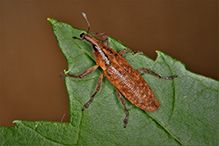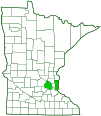terminal cylindrical weevil
(Lixus terminalis)
Conservation • Description • Habitat • Ecology • Distribution • Taxonomy
|
|
||||||||||||||
Description |
Terminal cylindrical weevil is a medium-sized true weevil. It occurs across North America. The body is elongated, cylindrical, smooth, and 5 ⁄16″ to 7 ⁄16″ (8 to 11 mm) long. The overall color is walnut brown, at least in museum specimens. The thorax is composed of three segments. The first segment (prothorax) is large and prominent and appears to be the entire thorax. It is covered by a saddle-shaped plate (pronotum). The pronotum is longer than wide, has straight sides, is rounded vertically, and is depressed in the middle. It is slightly wider at the base than the wings at their base. The base is straight near the sides and has a small triangular projection (lobe) in the middle. The surface is pitted with scattered large and small punctures. There are two pairs of wings, a membranous inner pair and a hardened outer pair (elytra). The elytra are attached to the second thoracic segment (mesothorax). They cover the mesothorax, the third thoracic segment (metathorax), and completely cover the abdomen. They are wider than the pronotum, oblong egg-shaped, narrowed toward the tips, moderately convex, longitudinally grooved, and pitted. There is a deep depression at the base in the middle that joins the similar depression on the pronotum. The tips of the elytra are rounded and distinctly separated. The pronotum and elytra are covered with short, fine, gray hairs. These hairs wear off irregularly, becoming patchy on older individuals. The head is greatly elongated between the eyes and the mouth parts form a conspicuous snout (rostrum). The rostrum is relatively thickened, enlarged toward the tip, and very long, as long as the prothorax. It is projected forward and slightly bent downward. Antennae are inserted one fifth of the way from the tip. The antennae are short, slender, and elbowed. The last 3 segments are expanded and form a club. There are seven jointed segments between the base and the club. The first two segments are long, the second much longer than the first. The third through seventh segments are short. The first antennal segment (joint) beyond the base is thicker than the second joint. The second joint is as long or longer than the next two joints combined. The third leg segment (femur) is slightly club-shaped. |
Size |
Total length: 5 ⁄16″ to 7 ⁄16″ |
Similar Species |
Habitat |
|
Ecology |
Season |
One generation per year: April through August |
Behavior |
|
Life Cycle |
Overwintering adults become active in April. After mating, the female punctures the stem or crown of a host plant with her snout and feeds, creating a cavity. She then inserts a single egg about ⅛″ deep into the cavity. The egg hatches in 7 to 10 days. The larva burrows into the stalk or roots creating a gallery and pupates within the gallery. Adults overwinter in leaf litter. |
Larva Food |
Host plant stalks. Larvae have been reared on the laboratory on water smartweed and Pennsylvania smartweed. What the hosts are in nature is unknown. |
Adult Food |
Host plant soft tissues |
Distribution |
||
|
Sources |
|
| 7/6/2025 | ||
Occurrence |
||
|
||
Taxonomy |
|
Order |
Coleoptera (Beetles) |
Suborder |
Polyphaga (Water, Rove, Scarab, Long-horned, Leaf, and Snout Beetles) |
Infraorder |
Cucujiformia |
Superfamily |
Curculionoidea (snout and bark beetles) |
Family |
Curculionidae (true weevils) |
Subfamily |
Lixinae |
Tribe |
Lixini |
Genus |
Lixus |
Subordinate Taxa |
|
|
|
Synonyms |
|
Lixus blakeae |
|
Common Names |
|
terminal cylindrical weevil |
|
Glossary
Elytra
The hardened or leathery forewings of beetles used to protect the fragile hindwings, which are used for flying. Singular: elytron.
Femur
On insects and arachnids, the third, largest, most robust segment of the leg, coming immediately before the tibia. On humans, the thigh bone.
Pronotum
The exoskeletal plate on the upper side of the first segment of the thorax of an insect.
Prothorax
The first (forward) segment of the thorax on an insect, bearing the first pair of legs but not wings.
Rostrum
The stiff, beak-like projection of the carapace or prolongation of the head of an insect, crustacean, or cetacean.
Visitor Photos |
||
Share your photo of this insect. |
||
This button not working for you? |
||
Alfredo Colon |
 |
MinnesotaSeasons.com Photos |
||
|
||
|
||

Slideshows |
|

Visitor Videos |
||
Share your video of this insect. |
||
This button not working for you? |
||
|
Other Videos |
||
|

Created: 12/19/2018 Last Updated: © MinnesotaSeasons.com. All rights reserved. |


